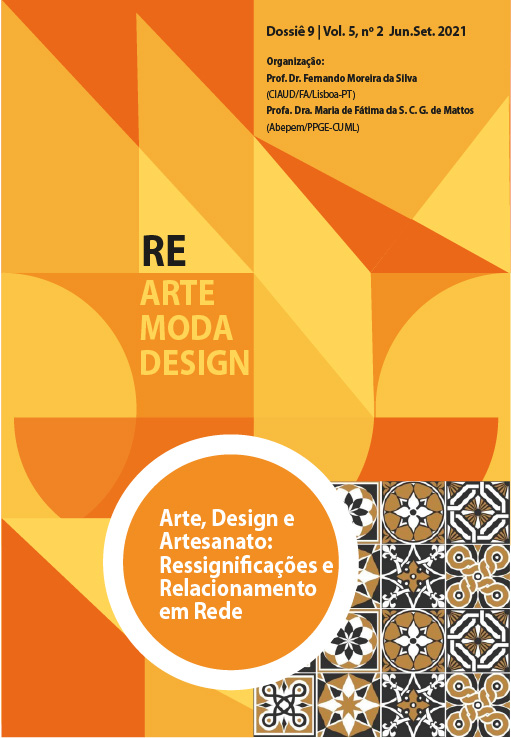A arte figurativa de mestras-artesãs do Alto do Moura, Caruaru - PE, e os sentidos estéticos e sensíveis sobre questões de gênero
DOI:
https://doi.org/10.5965/25944630522021031Palavras-chave:
Estética Feminista, Gênero, ImaginárioResumo
O presente estudo é uma análise estética, sensível e feminista da produção de artesanato em barro de uma mestra-artesã da comunidade do Alto do Moura, Caruaru, Pernambuco. O processo de análise e investigação refere-se às obras da mestra artesã Marliete Rodrigues, considerando que compreender as recorrências estéticas, sensíveis, simbólicas e subjetivas presentes na produção artística de mulheres artesãs pode evidenciar o imaginário que se constitui a partir das vivências socioculturais cotidianas das artistas sobre questões de gênero. A partir de dada dimensão fenomenológica, buscamos responder a perguntas como: Qual a centralidade dos elementos estéticos e sensíveis nas obras da artesã? Quais elementos de gênero e ligados ao cotidiano da comunidade são materializados através dos símbolos presentes nas obras analisadas? É possível caracterizar como feminista a estética que se desenvolve a partir do imaginário e é expressa em suas obras? Os resultados obtidos apontam que apesar de, à primeira vista, a obra da mestra parecer estar inscrita numa espécie de feminilidade compulsória, pelo uso recorrente de elementos ligados a flores, o recato no vestuário e as ações das mulheres retratadas, a obra de Marliete se revela dissidente ao propor sutis rupturas nas estruturas a partir das quais a arte em barro da comunidade do Alto do Moura é constituída.
Downloads
Referências
ALMEIDA, Flavia Leme de. Mulheres recipientes: recortes poéticos do universo feminino nas artes Visuais. São Paulo: Editora UNESP; Cultura Acadêmica, 2010.
ASSIS, Sissa Aneleh Batista de. Mulheres Artistas: narrativas, poéticas, subversões e protestos do feminino na arte contemporânea paraense. 2012. 128 f. Dissertação (Mestrado em Artes) – Instituto de Ciências da Arte – ICA, Universidade Federal do Pará, Belém.
BOVENSCHEN, Silvia. Existe uma estética feminista? In: ECKER, Gisela. Feminist Aesthetics. 1. ed. Barcelona: Icaria Editorial, 1986. p. 21-58.
BUTLER, Judith. Problemas de Gênero: feminismo e subversão da identidade. Trad. Renato Aguiar. 2. ed. Rio de Janeiro: Civilização Brasileira, 2003.
CARVALHO, Mário de Faria; As performances contestatórias do Coletivo Monstruosas: exemplificação de transgressão na arte. No prelo, 2019.
CARVALHO, Mário de Faria; CARDOSO, Fernando da Silva. Contemporaneidade, Pesquisa Social e Imaginário. Revista Nupem, Campo Mourão, v. 7, n. 13, p. 105-117, 2015. Disponível em: http://fecilcam.br/revista/index.php/nupem/article/viewFile/793/603. Acesso em: 14 nov. 2019.
DURAND, Gilbert. As estruturas antropológicas do imaginário: introdução à arquetipologia geral. Tradução Hélder Godinho. 2. ed. São Paulo: Martins Fontes, 2001.
DURAND, Gilbert. O imaginário: ensaio acerca das ciências e da filosofia da imagem. Tradução Rennée Eve Levié. 3. ed. Rio de Janeiro: DIEFEL, 2004.
FONSECA, Fernanda; DIAS, Tânia; CAMPOS, Roberta. A divisão sexual do trabalho e as desigualdades sociais entre homens e mulheres na arte do barro no Alto do Moura - Pernambuco/Brasil. In: Anais... XXXI Congresso ALAS, 2017, Montevideo. Montevideo: Asociación Latino Americana de Sociología, 2017. v. XXXI.
GOMES, Graciele Maria Coelho de Andrade; CARVALHO, Mario de Faria. (2020). Por uma pedagogia do belo: educação, estética e sensibilidades. EccoS – Revista Científica, n. 53, e16647, 2020. doi: https://doi.org/10.5585/eccos.n53.16647.
KORSMEYER, Carolyn. Gender and aesthetics: an introduction. 1. ed. New York: Routledge, 2014. p. 1-9.
MAFFESOLI, Michel. Elogio da razão sensível. Petrópolis: Vozes, 1998.
MAFFESOLI, Michel. No fundo das aparências. Petrópolis: Vozes, 1996.
MELO, Rosilene Alves de. Saberes e formas de expressão: patrimônio de todos nós. Formação de Mediadores de Educação Patrimonial. Fortaleza: [s. e.], 2019. Disponível em: https://cursos.fdr.org.br/pluginfile.php/416735/mod_resource/content/15/index.html. Acesso em: 30 jun. 2020.
MESKIMMON, Marsha. Women Making Art: history, subjectivity, aesthetics. 1. ed. Abingdon: Routledge, 2003. p. 1-3.
NOCHLIN, Linda. Por que não houve grandes mulheres artistas? Tradução de Juliana Vacaro. São Paulo: Edições Aurora, 2016.
NUÑEZ, Marcela Bautista. Movimentos de resistência entre gênero, arte contemporânea e educação. Educação, Artes e Inclusão, Santa Catarina, v. 14, n. 4, p. 248-270, dez., 2018. Disponível em: http://www.revistas.udesc.br/index.php/arteinclusao/article/view/11579. Acesso em: 27 abr. 2020.
RAYMOND, Claire. Pode haver uma estética feminista? Comunicação e Sociedade [online], v. 32, n. 32, p. 31-44, 2019. Disponível em: http://www.scielo.mec.pt/pdf/csoc/v32/v32a02.pdf. Acesso em: 14 nov. 2019.
SENNA, Nádia. da Cruz. Donas da beleza: a imagem feminina na cultura ocidental pelas artistas plásticas do século XX. 2007. 212 f. Tese (Doutorado em Ciências da Comunicação) - Escola de Comunicação e Artes da Universidade de São Paulo, São Paulo.
STUBS, Roberta; TEIXEIRA-FILHO, Fernando Silva; LESSA, Patrícia. Artvismo, estética feminista e produção de subjetividade. Revista Estudos Feministas, Florianópolis, v. 26, n. 2, p. 1-19, 2018. Disponível em: <https://periodicos.ufsc.br/index.php/ref/article/view/38901/37096 >.
Acesso em: 14 nov. 2019.
TVARDOVSKAS, Luana Saturnino. Dramatização dos corpos: Arte contemporânea e crítica feminista no Brasil e na Argentina. 1. ed. São Paulo: Intermeios, 2015.
Publicado
Como Citar
Edição
Seção
Licença
Copyright (c) 2021 Ilzy Gabrielle Soares da Silva, Mário de Faria Carvalho

Este trabalho está licenciado sob uma licença Creative Commons Attribution 4.0 International License.
- Autores mantém os direitos autorais e concedem à revista o direito de primeira publicação, com o trabalho simultaneamente licenciado sob a Licença Creative Commons Attribution 4.0 Internacional, que permite:
1. Compartilhar — copiar e redistribuir o material em qualquer suporte ou formato para qualquer fim, mesmo que comercial.
2. Adaptar — remixar, transformar, e criar a partir do material para qualquer fim, mesmo que comercial.
O licenciante não pode revogar estes direitos desde que você respeite os termos da licença.De acordo com os termos seguintes:
1. Atribuição — Você deve dar o crédito apropriado, prover um link para a licença e indicar se mudanças foram feitas . Você deve fazê-lo em qualquer circunstância razoável, mas de nenhuma maneira que sugira que o licenciante apoia você ou o seu uso.
2. Sem restrições adicionais — Você não pode aplicar termos jurídicos ou medidas de caráter tecnológico que restrinjam legalmente outros de fazerem algo que a licença permita -
Plágio, em todas as suas formas, constitui um comportamento antiético de publicação e é inaceitável. Esta revista utiliza o software iThenticate de controle de similaridade.






